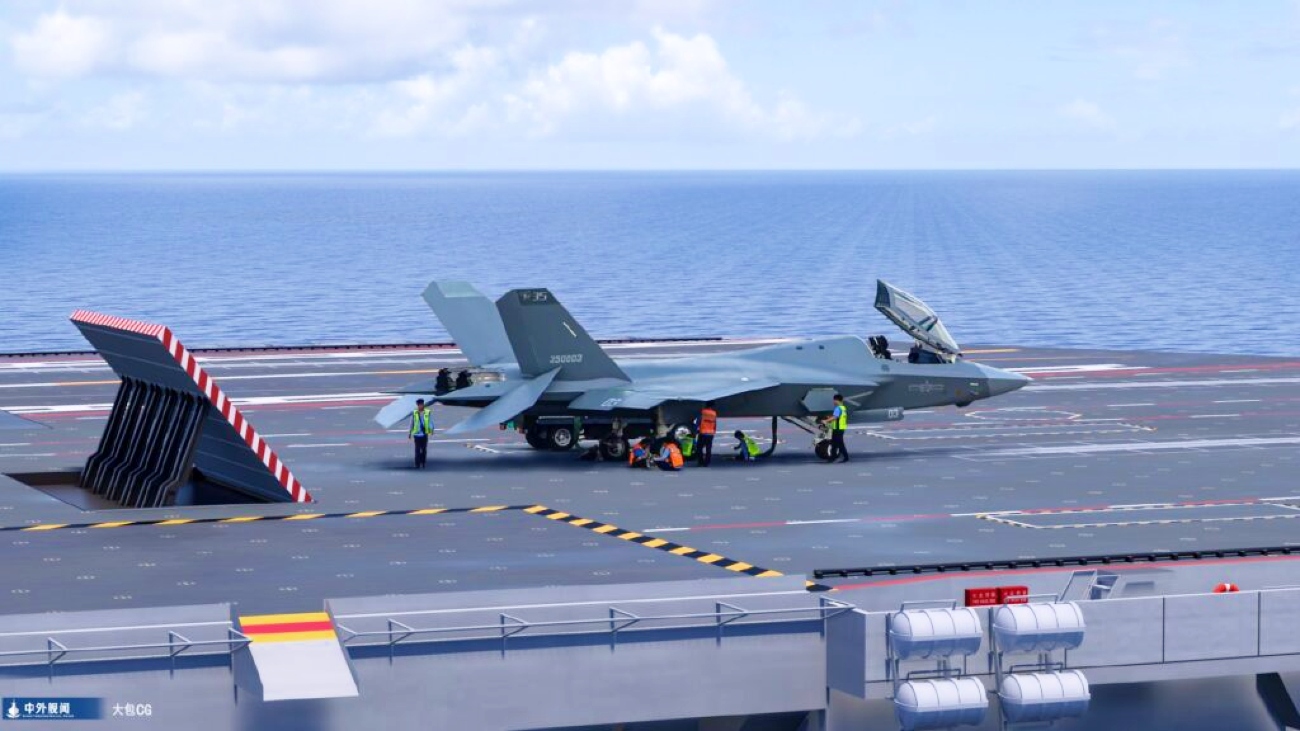The first video of China’s J-35 carrier-based stealth fighter undergoing flight tests has emerged on social media, indicating the aircraft’s rapid development and the People’s Liberation Army Navy’s (PLAN) steady progress toward acquiring complete operational carrier capability.
The video, posted by several handles on X (formerly Twitter), showed the twin-engine J-35 in a possibly grey paint scheme, with landing gears down in what looks like the plane coming in for a landing.
China has two operational aircraft carriers, the Liaoning and the Shandong. A third one, the Fujian, has been launched and is being readied for harbor and sea trials. Developed by Shenyang Aircraft Corporation (SAC), the J-35, Beijing’s second stealth fighter after Chengdu’s J-20, is slated to operate from all three carriers.
China’s second carrier-based fighter, the J-15 (a Chinese derivative of the Sukhoi Su-33), is the larger, heavier jet primarily assessed as PLAN’s primary air superiority/multirole mainstay.
The J-35, given its relatively lighter and smaller profile, might undertake the basic aerial protection roles for the fleet and integral support for the J-15s from enemy fighters, while the latter conducts the complex anti-ship and ground strike missions.
J-35 Needed To Challenge US F-35
The PLAN and the People’s Liberation Army Air Force (PLAAF) had previously rejected the Shenyang Aircraft Corporation (SAC)-built J-35 (then called the FC-31 Gyrfalcon). The project, however, was believed to be resurrected as tensions with the US in the western Pacific increased under former US President Donald Trump.
Even during the pandemic, it is said that China made significant progress on this program. “(The J-35 program) is the poster child for military opportunism the PRC has displayed during the COVID epidemic,” a NATO intel officer previously told the Bulwark.
J35 during test flights in China. pic.twitter.com/bQtgLUlRA3
— International Defence Analysis (@Defence_IDA) August 25, 2023
“Increased building up of their man-made islands in the South China Sea, escalation of bomber and fighter flights almost daily harassing the Republic of China (on Taiwan), wolf-warrior diplomacy, etc. It is all part of their game of ‘how much can we get away with while you are locked at home and not paying attention,'” NATO intel officer added.
Design & Features
July 2022 saw the J-35’s first clear image on the ground with the maintenance crew surfacing. This had the serial number 35003 and a gray tactical paint job. It is unclear if the jet in the video is the same as in the July 2022 photo.
However, that picture showed a pitot tube in the nose, while the jet in the latest video did not have one. This indicates the concluding phases of flight testing and installing a radar system in the nose. The J-35 will have an advanced Active Electronically Scanned Array (AESA) radar, being a fifth-generation fighter.
There is a similarity in the J-35’s canopy configuration and that of the F-35B variant that features the short take-off and vertical landing (STOVL) capability for use on the universal amphibious ships of the US Marine Corps and the US Navy.
In the J-35 and F-35B, the upper part of the fuselage is merged with the rear part of the canopy (behind the cockpit). In the case of the F-35B, this part houses a lifting fan to enable vertical take-off and landing.
The J-35, however, is not a STOVL aircraft. This also leads to the question of which of the three carriers the J-35 will likely operate from. With the Fujian featuring an Electromagnetic Launch System (EMALS) that allows launching even heavier aircraft with full loads, limiting the J-15s to the Liaoning and the Shandong would be pointless.
Thus, logically, it can be guessed that once ready after sea trials and while being operationalized, Fujian might carry largely the J-15 and a small complement of J-35s, with the ratio being inverted on the Liaoning and the Shandong.

Indeed, this does not mean the J-35 cannot carry heavier payloads on the outboard stations under the wing or the belly. Still, such a stealth-compromising configuration would only be flown in missions not requiring radar invisibility.
However, the fighter-type allotment for each carrier is, at best, an informed guess. We would have to wait a few years for further developments or reports from official state-affiliated media.
US Watching Closely
The J-35’s appearance in July 2021 had “caught the attention of US defense policymakers,” according to a Breaking Defense report.
A retired US naval intelligence officer, Captain James Fanell, told Breaking Defense that the J-35 could be another critical turning point in China’s long-term quest for a blue-water carrier-based naval aviation capability.
“We are seeing the goals of (now retired) Admiral Wu Shengli coming to fruition as the PLAN continues its transformation into the most powerful navy on the planet,” he said.
Fanell further argues that the lack of transparency on the part of the Chinese government is why we keep being “surprised” by developments like the J-35.
- The author can be reached at satamp@gmail.com
- Follow EurAsian Times on Google News




